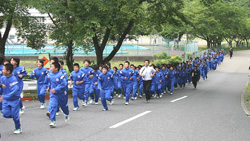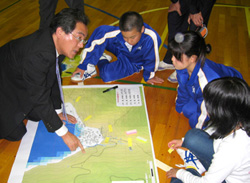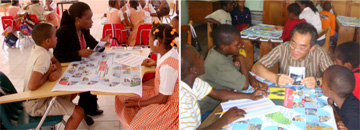Home > Highlighting JAPAN > Highlighting Japan MARCH 2013 > LESSONS FROM DISASTERS
Highlighting JAPAN
COVER STORY: LESSONS FROM DISASTERS
LESSONS FROM DISASTERS
Almost two years have passed since the Great East Japan Earthquake on March 11, 2011. Japan has experienced numerous disasters in its long history, and following a disaster Japan has improved its bosai measures for prevention and mitigation of disasters in areas such as flood control, forest conservation, weather observation and evacuation systems. In the 1940s and 1950s, more than 1,000 lives were lost annually due to natural disasters, but in recent years casualties have fallen to fewer than 100. Even so, the damage brought by the Great East Japan Earthquake was far greater than Japanese could have imagined. Based on the lessons learned from the experience, Japan is now working on new measures for preventing and mitigating disasters in an effort to facilitate reconstruction. This month's Cover Story introduces some of the lessons learned from the country's various disasters.

School students and local residents participate in an evacuation drill in Kamaishi, Iwate Prefecture, in 2009.
Credit: COURTESY OF TOSHITAKA KATADA
"The children attribute it to 'Achievements of Kamaishi.' Their survival is not a miracle considering that they made consistent efforts, did the right things at the right time and obtained the outcome they deserved," says Toshitaka Katada, a professor at Gunma University. "However, Kamaishi lost five children, so I was somewhat reluctant to use the word 'miracle.' I'm now leaning toward placing greater importance on this phrase, the 'Miracle of Kamaishi,' to ensure that the children's actions are remembered down through the generations."
Since 2004, Professor Katada has cooperated with local elementary and junior high school teachers in providing disaster prevention education in Kamaishi. Notably, he strongly advised local children to follow three principles of evacuation: do not get fixated on assumptions, do whatever you can do in the given situation, and take the initiative in evacuating.

Professor Toshitaka Katada explains the tsunami evacuation map to junior high school students in Kamaishi.
Credit: COURTESY OF TOSHITAKA KATADA
Many survivors in Kamaishi began evacuating after seeing local junior high school students who were running while loudly and vocally informing others before the tsunami reached the land, advising them to evacuate immediately. One older survivor was at first reluctant to evacuate believing that the breakwater would protect him, before the cries of his grandchild impelled them to flee. Many parents averted the tsunami by evacuating without attempting to find their children, believing their children would evacuate by themselves. The children did exactly that, and took the initiative.
Kamaishi's junior high school students were typically encouraged to develop from the saved into the saver. For instance, they received evacuation drills together with elementary schoolchildren and were trained to use two-wheeled carts to carry the elderly. When the Great East Japan Earthquake hit, the junior high school students took the elementary schoolchildren's hands or carried the elderly on their back to successfully evacuate, as they had been trained to do.

Professor Toshitaka Katada teaches disaster prevention through a game at primary schools on the Caribbean island of Saint Vincent (right) and on the Turks and Caicos islands in the Bahamas in 2007.
Credit: COURTESY OF TOSHITAKA KATADA
Professor Katada is also involved in activities to spread disaster prevention education in Latin America. One such activity is the Project on Capacity Development for Disaster Risk Management in Central America, BOSAI, organized by the Japan International Cooperation Agency (JICA). ("Bosai" is a Japanese word meaning disaster prevention and mitigation.) Through workshops with local people, Professor Katada communicates advice for evacuating from tsunamis, erupting volcanoes, heavy rain, landslides and other types of disaster, as well as the importance of handing down experiences of coming through from a disaster.
"People try to forget bitter memories, but these memories must be utilized as lessons," Professor Katada says. "With a vivid memory of the Great East Japan Earthquake, we have the responsibility to ensure, for future generations, that evacuating is a certainty whenever a tsunami occurs. In other words, evacuation must be made a part of our culture."
© 2009 Cabinet Office, Government of Japan






